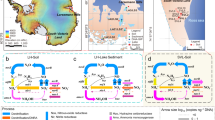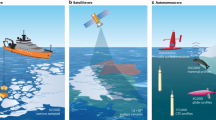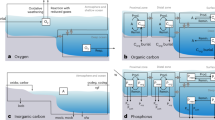Abstract
Methane is a potent greenhouse gas that has contributed approximately 20% to the Earth’s warming since pre-industrial times. The world’s oceans are an important source of methane, comprising 1–4% of annual global emissions. But despite its global significance, oceanic methane production is poorly understood. In particular, methane concentrations in the surface waters of most of the world’s oceans are supersaturated with respect to atmospheric concentrations, but the origin of this methane, which has been thought to be produced exclusively in anaerobic environments, is not known. Here, we measure methane production in seawater samples amended with methylphosphonate, an organic, phosphorus-containing compound. We show that methane is produced aerobically as a by-product of methylphosphonate decomposition in phosphate-stressed waters. Methylphosphonate decomposition, and thus methane production, may be enhanced by the activity of nitrogen-fixing microorganisms. We suggest that aerobic marine methane production will be sensitive to the changes in water-column stratification and nutrient limitation that are likely to result from greenhouse-gas-induced ocean warming.
This is a preview of subscription content, access via your institution
Access options
Subscribe to this journal
Receive 12 print issues and online access
$259.00 per year
only $21.58 per issue
Buy this article
- Purchase on Springer Link
- Instant access to full article PDF
Prices may be subject to local taxes which are calculated during checkout



Similar content being viewed by others
References
Reeburgh, W. S. Oceanic methane biogeochemistry. Chem. Rev. 107, 486–513 (2007).
Quay, P. et al. The isotopic composition of atmospheric methane. Glob. Biogeochem. Cycles 13, 445–461 (1999).
Lamontagne, R. A., Swinnerton, J. W., Linnenbom, V. J. & Smith, W. D. Methane concentrations in various marine environments. J. Geophys. Res. 78, 5317–5324 (1973).
Scranton, M. I. & Brewer, P. G. Occurrence of methane in the near-surface waters of the western subtropical North Atlantic. Deep-Sea Res. 24, 127–138 (1977).
Tilbrook, B. D. & Karl, D. M. Methane sources, distributions and sinks from California coastal waters to the oligotrophic North Pacific gyre. Mar. Chem. 49, 51–64 (1995).
Rudd, J. W. M. & Taylor, C. D. Methane cycling in aquatic environments. Adv. Aquat. Microbiol. 2, 77–150 (1980).
Kiene, R. P. in Microbial Production and Consumption of Greenhouse Gases: Methane, Nitrogen Oxides, and Halomethanes (eds Rogers, J. E. & Whitman, W. B.) 111–146 (ASM, Washington DC, 1991).
Karl, D. M. & Björkman, K. M. in Biogeochemistry of Marine Dissolved Organic Matter (eds Hansell, D. & Carlson, C.) 246–366 (Elsevier Science, Amsterdam, 2002).
Kittredge, J. S. & Roberts, E. A carbon–phosphorus bond in nature. Science 164, 37–42 (1969).
Kittredge, J. S., Horiguchi, M. & Williams, P. M. Aminophosphonic acids: Biosynthesis by marine phytoplankton. Comput. Biochem. Physiol. 29, 859–863 (1969).
Kolowith, L. C., Ingall, E. D. & Benner, R. Composition and cycling of marine organic phosphorus. Limnol. Oceanogr. 46, 309–320 (2001).
Benitez-Nelson, C. R., O’Neill, L., Kolowith, L. C., Pellechia, P. & Thunell, R. Phosphonates and particulate organic phosphorus cycling in an anoxic marine basin. Limnol. Oceanogr. 49, 1593–1604 (2004).
Cook, A. M., Daughton, C. G. & Alexander, M. Phosphonate utilization by bacteria. J. Bacteriol. 133, 85–90 (1978).
White, A. K. & Metcalf, W. Microbial metabolism of reduced phosphorus compounds. Ann. Rev. Microbiol. 61, 379–400 (2007).
Kononova, S. V. & Nesmeyanova, M. A. Phosphonates and their degradation by microorganisms. Biochemistry 67, 184–195 (2002).
Daughton, C. G., Cook, A. M. & Alexander, M. Biodegradation of phosphonate toxicants yields methane or ethane on cleavage of the C–P bond. FEMS Microbiol. Lett. 5, 91–93 (1979).
Huang, J., Su, Z. & Xu, Y. The evolution of microbial phosphonate degradative pathways. J. Mol. Evol. 61, 682–690 (2005).
DeLong, E. F. et al. Community genomics among stratified microbial assemblages in the ocean’s interior. Science 311, 496–503 (2006).
Venter, J. C. et al. Environmental genome shotgun sequencing of the Sargasso Sea. Science 304, 66–74 (2004).
Moran, M. A. et al. Genome sequence of Silicibacter pomeroyi reveals adaptations to the marine environment. Nature 432, 910–913 (2004).
Dyhrman, S. T. et al. Phosphonate utilization by the globally important marine diazotroph Trichodesmium. Nature 439, 68–71 (2006).
Oremland, R. S. Methanogenic activity in plankton samples and fish intestines: A mechanism for in situ methanogenesis in oceanic surface waters. Limnol. Oceanogr. 24, 1136–1141 (1979).
Marty, D. G. Methanogenic bacteria in seawater. Limnol. Oceanogr. 38, 452–456 (1993).
de Angelis, M. A. & Lee, C. Methane production during zooplankton grazing on marine phytoplankton. Limnol. Oceanogr. 39, 1298–1308 (1994).
Karl, D. M. & Tilbrook, B. D. Production and transport of methane in oceanic particulate organic matter. Nature 368, 732–734 (1994).
Sannigrahi, P., Ingall, E. D. & Benner, R. Nature and dynamics of phosphorus-containing components of marine dissolved and particulate organic matter. Geochim. Cosmochim. Acta 70, 5868–5882 (2006).
Tilbrook, B. D. & Karl, D. M. Dissolved methane distributions, sources, and sinks in the Western Bransfield Strait, Antarctica. J. Geophys. Res. 99, 16383–16393 (1994).
Crutzen, P. J. Methane’s sinks and sources. Nature 350, 380–381 (1991).
Dlugokencky, E. J., Masarie, K. A., Lang, P. M. & Tans, P. P. Continuing decline in the growth rate of the atmospheric methane burden. Nature 393, 447–450 (1998).
Fiore, A. M., Horowitz, L. W., Dlugokencky, E. J. & West, J. J. Impact of meteorology and emissions on methane trends, 1990–2004. Geophys. Res. Lett. 33, L12809 (2006).
Karl, D. M. A sea of change: Biogeochemical variability in the North Pacific subtropical gyre. Ecosystems 2, 181–214 (1999).
Björkman, K. M. & Karl, D. M. Bioavailability of dissolved organic phosphorus in the euphotic zone at Station ALOHA, North Pacific Subtropical Gyre. Limnol. Oceanogr. 48, 1049–1057 (2003).
Karl, D. M. Microbial oceanography: paradigms, processes and promise. Nature Rev. Microbiol. 5, 759–769 (2007).
Moore, J. K., Doney, S. C., Lindsay, K., Mahowald, N. & Michaels, A. F. Nitrogen fixation amplifies the ocean biogeochemical response to decadal timescale variations in mineral dust deposition. Tellus 58, 560–572 (2006).
Hutchins, D. A. et al. CO2 control of Trichodesmium N2 fixation, photosynthesis, growth rates, and elemental ratios: Implications for past, present, and future ocean biogeochemistry. Limnol. Oceanogr. 52, 1293–1304 (2007).
Polovina, J. J., Howell, E. A. & Abecassis, M. Ocean’s least productive waters are expanding. Geophys. Res. Lett. 35, L03618 (2008).
Diaz, J. et al. Marine polyphosphate: A key player in geologic phosphorus sequestration. Science 320, 652–655 (2008).
LaRoche, J. & Breitbarth, E. Importance of the diazotrophs as a source of new nitrogen in the ocean. J. Sea Res. 53, 67–91 (2005).
Acknowledgements
The authors thank J. Dore for advice and assistance with methane determinations, and A. White and R. Letelier for field assistance, expertise and leadership during the August 2007 R/V Kilo Moana BloomER expedition. This research was supported by the Gordon and Betty Moore Foundation and the National Science Foundation and is a contribution from the Center for Microbial Oceanography: Research and Education (C-MORE).
Author information
Authors and Affiliations
Contributions
D.M.K. formulated the hypothesis, directed the research and wrote the first draft of the manuscript. L.B. and K.B. carried out most of the experiments. E.F.D. and A.M. conducted and analysed the genome database search. All authors contributed to the experimental design, data interpretation and preparation of the final draft of the manuscript.
Corresponding author
Rights and permissions
About this article
Cite this article
Karl, D., Beversdorf, L., Björkman, K. et al. Aerobic production of methane in the sea. Nature Geosci 1, 473–478 (2008). https://doi.org/10.1038/ngeo234
Received:
Accepted:
Published:
Issue Date:
DOI: https://doi.org/10.1038/ngeo234
This article is cited by
-
Phosphonate consumers potentially contributing to methane production in Brazilian soda lakes
Extremophiles (2024)
-
Bacterial aerobic methane cycling by the marine sponge-associated microbiome
Microbiome (2023)
-
The facilitating role of phycospheric heterotrophic bacteria in cyanobacterial phosphonate availability and Microcystis bloom maintenance
Microbiome (2023)
-
Methylphosphonate-driven methane formation and its link to primary production in the oligotrophic North Atlantic
Nature Communications (2023)
-
Methane emissions offset atmospheric carbon dioxide uptake in coastal macroalgae, mixed vegetation and sediment ecosystems
Nature Communications (2023)



